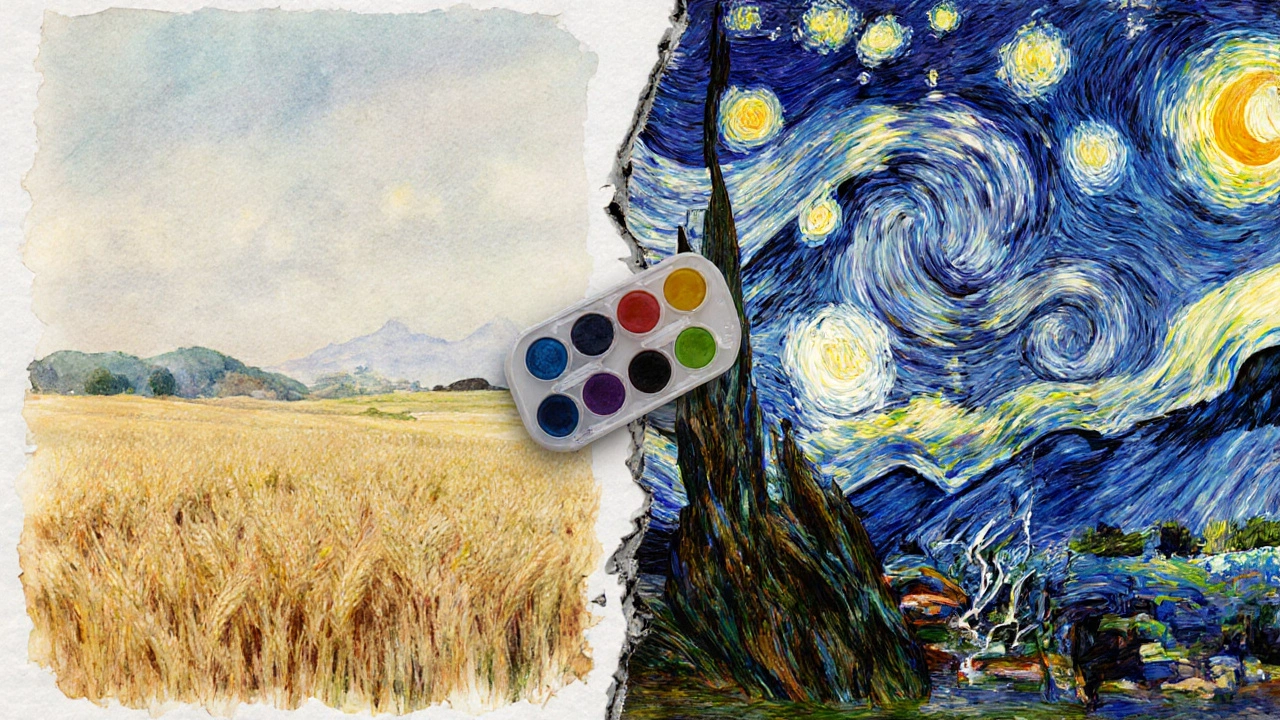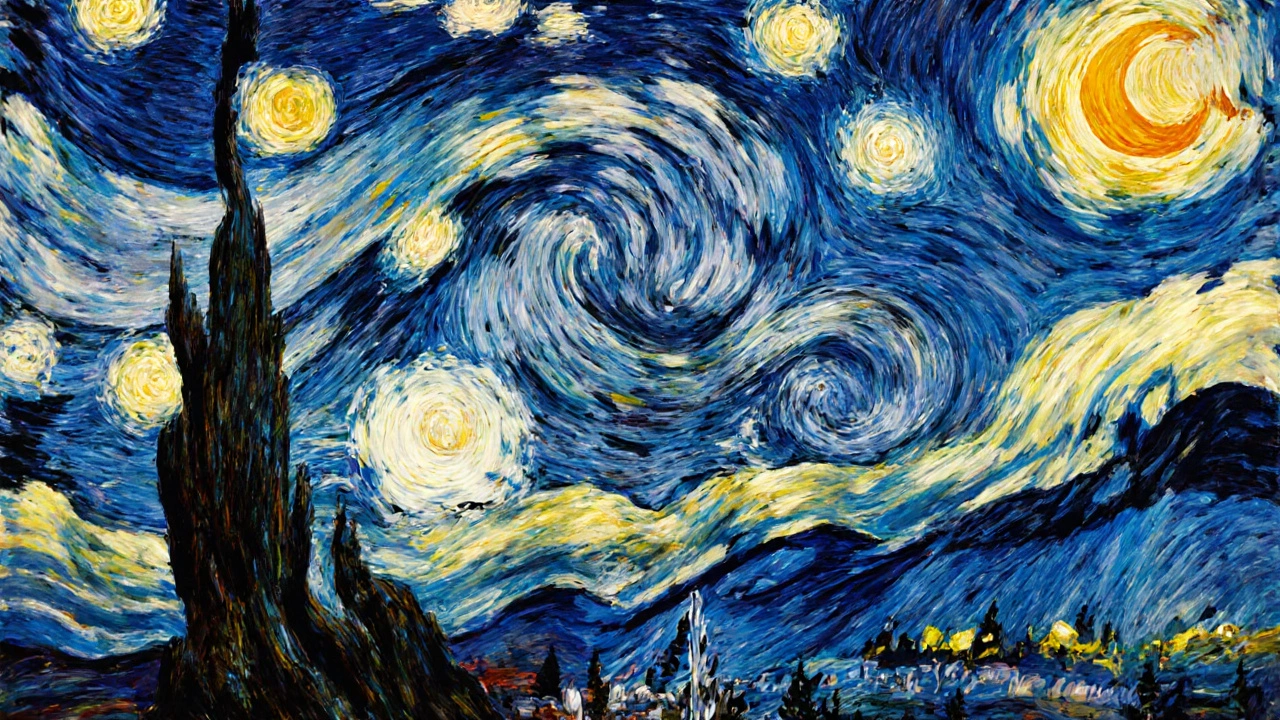People often assume Vincent van Gogh painted Starry Night with watercolor because of its swirling, fluid look. The blues and yellows seem to bleed into each other like wet-on-wet watercolor. But that’s not how it was made. Van Gogh didn’t use watercolor at all. He painted The Starry Night with oil on canvas - thick, heavy, textured oil paint. The movement you see? That’s brushwork, not runny pigment.
Why Do People Think It’s Watercolor?
The confusion makes sense. Watercolor has a reputation for soft edges and luminous washes. When you look at Starry Night, the sky feels alive, like it’s moving. The stars glow. The cypress tree twists like smoke. It looks like it could’ve been made with a wet brush on paper. But watercolor can’t do what oil paint did here.
Watercolor is transparent. It sits on top of the paper. Van Gogh’s sky is opaque, layered, built up. You can see ridges of paint in high-res images - thick strokes of cobalt blue, titanium white, and cadmium yellow. He used a palette knife sometimes, pushing paint around like butter. Watercolor doesn’t hold that kind of texture. It dries flat. Van Gogh’s paint dried raised, almost sculpted.
What Medium Did Van Gogh Actually Use?
Van Gogh worked almost exclusively in oil paint from 1881 until his death in 1890. He bought his pigments from art supply stores in Paris and Arles. His letters to his brother Theo are full of details about the brands he used: Rowney’s, Winsor & Newton, and local French makers. He wrote about how he mixed his own greens and how he saved his best cadmium yellow for sunflowers and stars.
Starry Night was painted in June 1889, while he was in the Saint-Paul-de-Mausole asylum in Saint-Rémy-de-Provence. He painted it from memory and from his window. He didn’t have access to watercolor supplies there - his focus was on oil. The museum that owns it, the Museum of Modern Art in New York, lists the medium as “oil on canvas” in their official records. No watercolor was involved.
Did Van Gogh Ever Use Watercolor?
Yes - but only early on. Before he became a full-time painter, Van Gogh experimented with watercolor during his time as a missionary and art dealer in the 1870s. He made a few sketches and studies in watercolor, mostly landscapes and figures. But they’re small, faint, and not finished works. None of them resemble Starry Night.
By 1883, he’d moved on. He called watercolor “too weak” for what he wanted to express. He needed color that could scream, not whisper. Oil paint gave him that. He layered it, scraped it, built it up. He painted the same scene five or six times until the emotion felt right. Watercolor doesn’t allow that kind of revision. Once it dries, you can’t go back.

How Oil Paint Made Starry Night Possible
Oil paint dries slowly. That’s why Van Gogh could work on it for hours, even days. He could blend colors while wet. He could scrape off a section and repaint it. He could apply thick strokes - impasto - that catch the light and cast tiny shadows. That’s what makes the stars in Starry Night feel like they’re pulsing.
Watercolor can’t do that. It’s fast-drying, unpredictable, and unforgiving. One wrong brushstroke and the whole thing bleeds. Van Gogh needed control over chaos. Oil gave him that. He used a stiff hog-hair brush to drag paint across the canvas in tight spirals. The swirls in the sky aren’t accidental. They’re deliberate, repeated, almost rhythmic.
Compare Starry Night to his watercolor sketch of a wheat field from 1880. The colors are pale. The lines are loose. It’s charming, but it doesn’t have the same emotional weight. Starry Night was painted with a different kind of intensity - the kind only oil paint can carry.
What Happens When Artists Try to Reproduce It in Watercolor?
Many modern artists try to recreate Starry Night using watercolor. YouTube tutorials show people blending blues and yellows to mimic the swirls. Some get close - but they’re copying the look, not the technique. Their versions are flat. The stars don’t glow from within. The sky doesn’t feel thick enough to touch.
That’s because watercolor lacks the physicality of oil. You can’t build up layers without turning the paper to mush. You can’t scrape or scratch into it without tearing. Van Gogh’s brushstrokes are physical marks. Watercolor can’t replicate that. It’s a different language.
One art conservator at the Van Gogh Museum in Amsterdam told me: “You can’t fake impasto with watercolor. It’s like trying to sculpt with mist.”

Why the Myth Persists
Why do people keep thinking it’s watercolor? Because it’s easier to believe. Watercolor feels romantic - spontaneous, delicate, natural. Oil paint feels heavy, messy, industrial. We want art to feel effortless. We want the sky to have been painted in a single breath.
But Van Gogh didn’t paint Starry Night in a single breath. He painted it over days. He worked until his hand ached. He used paint that cost money. He used brushes that wore out. He didn’t have a studio. He painted in a small room with a view of the night sky. He was alone. He was struggling. He poured everything into that canvas.
The myth of watercolor makes the painting feel gentler. But the truth? It’s more powerful. This wasn’t a gentle splash of color. It was a battle. A cry. A storm captured in oil.
What You Can Learn from This
If you’re an artist trying to capture emotion in your work, don’t get stuck on the medium. Van Gogh didn’t choose oil because it was trendy. He chose it because it let him say what he needed to say. Watercolor might be perfect for your quiet landscapes. Oil might be right for your heavy emotions. But don’t confuse the tool for the message.
Look at the brushstrokes. Feel the texture. Ask: Could this be done with watercolor? If the answer is no - and it usually isn’t - then you’re seeing the real thing. Van Gogh’s genius wasn’t in his choice of color. It was in his choice of medium. And that choice changed everything.
Was Starry Night painted with watercolor?
No, Starry Night was painted with oil paint on canvas, not watercolor. Van Gogh used thick, layered oil strokes to create the swirling sky and glowing stars. Watercolor can’t achieve the texture, depth, or physical buildup seen in this painting.
Why does Starry Night look like watercolor?
The swirling, flowing lines and soft transitions between blue and yellow make it *feel* like watercolor. But those effects were created with oil paint applied in thick, deliberate brushstrokes. The illusion comes from Van Gogh’s mastery of movement and color contrast, not the medium itself.
Did Van Gogh ever use watercolor?
Yes, but only in his early years, before 1883. He made a few watercolor sketches during his time as a missionary and art dealer, but he abandoned the medium because he found it too weak for the emotional intensity he wanted in his art. All of his major works, including Starry Night, were done in oil.
Can you paint Starry Night in watercolor and still call it the same thing?
You can make a watercolor *interpretation* of Starry Night, but it won’t be the same artwork. Van Gogh’s version relies on the physical thickness of oil paint - the impasto, the texture, the way light catches the ridges. Watercolor lacks that dimension. It’s a different medium, a different experience.
What’s the difference between oil paint and watercolor in terms of technique?
Oil paint dries slowly, allowing blending, layering, and scraping. You can build up thick textures and repaint areas. Watercolor dries quickly, is transparent, and doesn’t allow much revision. Once it’s down, it’s hard to change. Van Gogh needed the control and flexibility oil gave him - especially for a complex piece like Starry Night.

